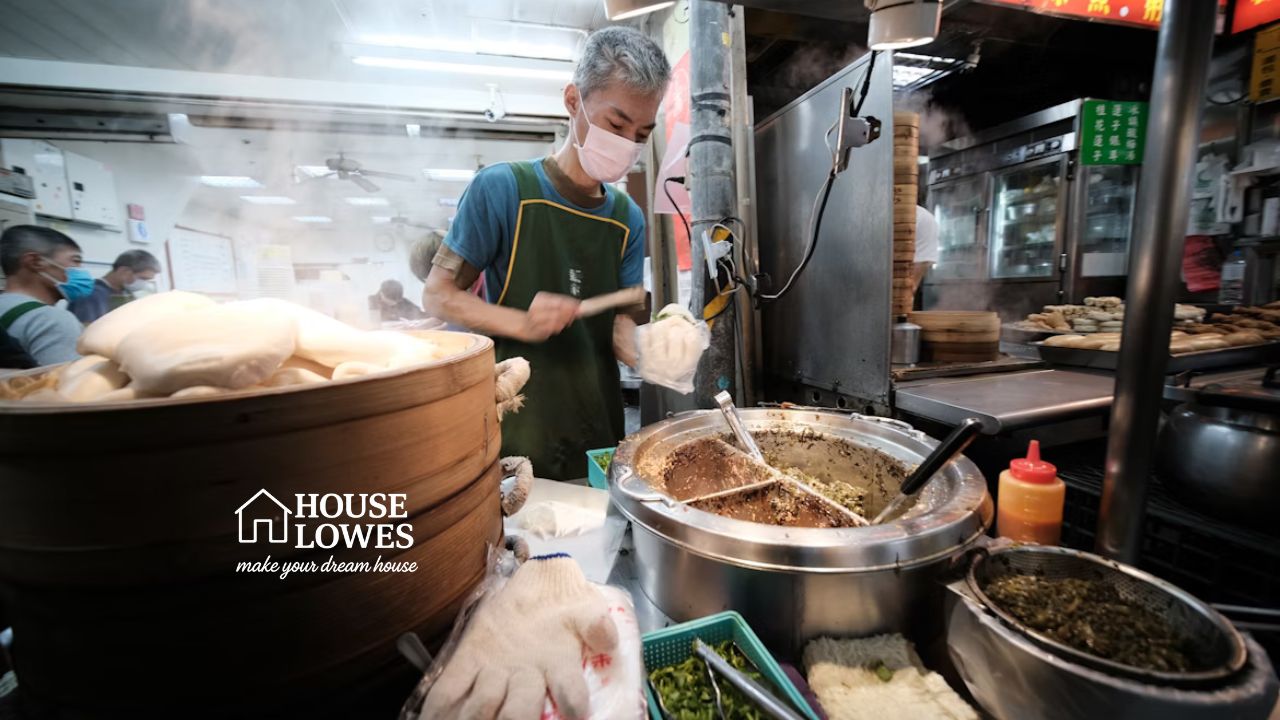Asian kitchens are more than just places where meals are prepared—they are vibrant hubs of cultural expression and culinary artistry. From the sizzling sounds of stir-fried noodles to the rich aromas of carefully spiced curries, these kitchens encapsulate the soul of a continent’s culinary tradition. Join us as we uncover the essence of Asian kitchens, their modern evolution, and the stories behind some of the most notable establishments.
Explore at a Glance
Here’s a quick overview of some popular Asian kitchen restaurants and their highlights:
| Restaurant Name | Specialties | Location | User Ratings |
|---|---|---|---|
| Wok Chi Asian Kitchen 鑊氣 | Stir-fries, hand-pulled noodles | New York City, NY | ⭐⭐⭐⭐ (4.2/5) |
| Bites Asian Kitchen Bar | Asian fusion tapas, craft cocktails | Miami, FL | ⭐⭐⭐⭐⭐ (4.5/5) |
| Chubby Crab Asian Wok & Cajun Kitchen | Asian-Cajun seafood boils, wok-seared dishes | Houston, TX | ⭐⭐⭐⭐ (4.3/5) |
| Zu Izakaya Asian Kitchen | Japanese izakaya specialties, sushi rolls | Atlanta, GA | ⭐⭐⭐⭐ (4.4/5) |
| Spice 8 Asian Kitchen | Thai curries, Indo-Chinese cuisine | Chicago, IL | ⭐⭐⭐⭐½ (4.6/5) |
Now that you’re intrigued, let’s dig deeper into the unique characteristics of Asian kitchens.
The Essence of an Asian Kitchen
At its core, an Asian kitchen is a symphony of tradition, technique, and innovation. Across the region, kitchens serve as spaces where ancient recipes meet modern-day adaptations, creating a fusion of history and flavor. But what truly sets Asian kitchens apart?
A Culture Told Through Ingredients
Rice, noodles, spices, fresh herbs, and soy-based sauces form the backbone of many Asian cuisines. For example:
- Rice is not just a staple but a cultural symbol of prosperity in many Asian countries.
- Aromatic spices like turmeric, star anise, and cardamom elevate dishes into aromatic masterpieces.
Cooking Techniques That Define the Experience
Known for their variety, Asian kitchens employ techniques like:
- Wok hei (or “breath of the wok”)—a unique charred flavor achieved by stir-frying food at extremely high heat.
- Steaming using bamboo steamers for delicacies like dim sum or sticky rice.
- Fermentation, central to creating staples like kimchi, soy sauce, and miso.
These methods reflect a philosophy of minimal waste and maximizing flavor—a hallmark of the Asian kitchen ethos.
Design and Functionality
Asian kitchens are also designed with practicality in mind:
- Open layouts for seamless cooking.
- Multi-tiered storage for a variety of fresh and dried ingredients.
- Specialty tools like cleavers, bamboo steamers, or cast-iron woks, ensuring that every dish has an authentic touch.
All these elements make Asian kitchens timeless and inspiring spaces for culinary creativity.
Discover modern architecture and residential design with Fly-Architecture. Get expert insights and inspiration for your home. Explore innovative ideas today.
Popular Asian Kitchen Restaurants
From humble street food stalls to upscale fusion spots, here are some standout Asian kitchen restaurants reshaping how we experience pan-Asian cuisine.
Wok Chi Asian Kitchen 鑊氣 (New York City, NY)
Known for its wok-based cooking techniques, this restaurant thrives on delivering fresh, made-to-order meals seasoned with the essence of “wok hei.” Customers rave about their beef chow fun and fiery kung pan chicken.
“The dishes feel alive! You can taste the freshness with every bite. A must-visit for authentic wok fare.” — User review, ⭐⭐⭐⭐
Bites Asian Kitchen Bar (Miami, FL)
Bites brings a twist to traditional Asian cuisine with its fusion-inspired small plates. Try the pork belly bao buns and sashimi tacos!
“Perfect spot for a dinner with friends—great food, great vibes, and amazing cocktails!” — User review, ⭐⭐⭐⭐⭐
Chubby Crab Asian Wok & Cajun Kitchen (Houston, TX)
This establishment marries classic Asian wok stir-fries with spicy Cajun-style seafood boils. Their garlic butter shrimp is adored by many.
“The flavors are bold yet perfectly balanced—a delightful blend of East meets West!” — User review, ⭐⭐⭐⭐
Zu Izakaya Asian Kitchen (Atlanta, GA)
Serving up Japanese izakaya (pub food), it’s famous for its karaage chicken and premium sushi rolls.
“The sushi is as fresh as it gets, and the ambiance transports you to Tokyo.” — User review, ⭐⭐⭐⭐
Spice 8 Asian Kitchen (Chicago, IL)
This kitchen specializes in Thai-style curries and Indo-Chinese dishes. Customer favorites include the drunken noodles and spicy butter chicken.
“Every bite was an explosion of flavor—an instant favorite!” — User review, ⭐⭐⭐⭐½
Each one of these establishments highlights the diversity within Asian kitchens, offering unique culinary experiences.
Modern Asian Kitchen Trends
With the culinary world constantly evolving, Asian kitchens are no exception. Here’s a glimpse at some exciting new trends:
- Asian Fusion Cuisine: Combining concepts from various culinary traditions (e.g., Korean BBQ tacos or Thai pizza).
- Sustainability Practices: Increased use of eco-friendly utensils and locally sourced, organic ingredients.
- Open Kitchen Concepts: Restaurants featuring open kitchens to enhance the dining experience by connecting diners with chefs.
- Tech-Driven Kitchens: Automation for preparing consistent noodles or using robots to make sushi.
For example, Qi Austin Modern Asian Kitchen has incorporated cutting-edge technology to perfect their noodle-making process, drawing in foodies and tech enthusiasts alike.
These innovations ensure that Asian kitchens remain at the forefront of global dining trends.
Spotlight on Regional Cuisines
Japanese Kitchen
Renowned for minimalism, Japanese kitchens focus on fresh, seasonal ingredients. From sushi chefs meticulously cutting sashimi to home cooks preparing comforting bowls of miso soup, every detail matters.
Thai Kitchen
Thai kitchens seduce the senses with tangy tamarind, aromatic lemongrass, and the heat of bird’s eye chilies. Staples include green curry and tom yum soup.
Vietnamese Kitchen
Expect light yet flavorful dishes like fresh spring rolls and pho, a fragrant noodle soup that has gained global fame.
Each region brings distinct influences that enrich the larger canvas of Asian kitchens.
Personal Backgrounds of Chefs
Many celebrated immigrants have built iconic Asian kitchens in Western countries, often starting with little and rising to success due to sheer talent and perseverance. One example is Mei Lin, a self-made chef and winner of cooking reality shows, with a thriving net worth from her restaurant empire. Similarly, Chef Roy Choi revolutionized Asian fusion in Los Angeles with his Korean-Mexican taco truck.
Make a statement with our designer purple wallpaper. Explore a curated selection of patterns in every shade imaginable, from amethyst to mauve. Shop the collection.
These individuals are more than chefs—they’re storytellers preserving heritage while innovating for a global audience.
FAQs About Asian Kitchens
Q1. What makes an Asian kitchen unique?
Asian kitchens stand out for their efficient design, use of fresh ingredients, bold flavors, and traditional cooking techniques like stir-frying, steaming, and fermenting.
Q2. What are must-try dishes in an Asian kitchen?
Popular choices include sushi, pad Thai, pho, dumplings, and bibimbap. Each dish reflects diverse regional flavors.
Q3. How are modern Asian kitchens adapting?
Many are emphasizing sustainability, open-kitchen designs, and fusion cuisine to cater to modern diners.
Q4. Are there tools unique to Asian kitchens?
Yes! Woks, bamboo steamers, cleavers, and rice cookers are essential tools that define the cooking process.
Q5. How can I recreate an authentic Asian kitchen at home?
Invest in a wok, stock up on fresh herbs like cilantro and mint, and experiment with soy sauce, fish sauce, and fermented chili paste for authenticity.
Final Word
Asian kitchens are a celebration of culture, flavor, and innovation. Whether you’re dining at an upscale restaurant like Wok Chi Asian Kitchen 鑊氣 or exploring home-style flavors at your local Vietnamese eatery, you’re partaking in a culinary legacy that spans centuries. Join the movement to experience, savor, and support the wonders of Asian kitchens worldwide.
Small living spaces reach new heights through strategic home and design innovations. Décor AD Tech maximizes spatial efficiency with smart lighting solutions, while House Lowes provides space-saving materials. Newtopy, Zyrendral, and Ksi-Home specialize in compact smart systems that optimize functionality. Tiny home luxury proves that limited square footage doesn’t limit style, comfort, or sophistication.
Admin Recommendation
Comprehensive Guide to Standing Seam Metal Roofing | Benefits & Costs







